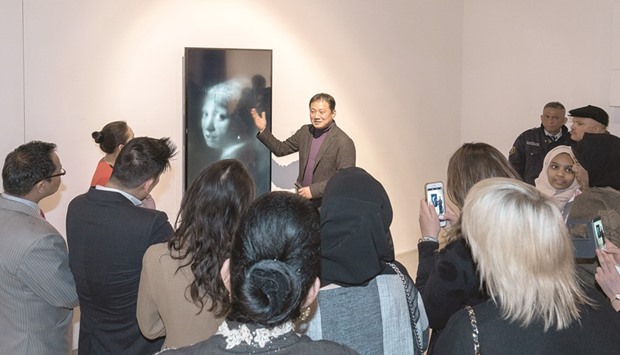Korean artist Lee Lee Nam has been variously hailed as a re-inventor of masterpieces and the second Nam June Paik. The exhibition at Katara featuring Lee Nam’s multi-faceted reinterpretations of classics — and supposed to come to a close today — has been extended until February 21. And you better not miss it.
The celebrated media artist’s exhibition at Building 5, Katara Art Centre, melds thought-stirring amalgamations of today’s high-tech environment and yesterday’s traditional culture memories in UHD clarity. Known for his distinct style of video art that breathes new life into famous classic paintings, Lee Nam’s work draws us deep into his creative and imaginative video art world, where things move and so do our emotions. Lee Nam’s gripping video works “juxtapose European old master paintings and traditional Asian art with modern day imagery.”
Art critic Ryu Byoung Hak says, “Lee Lee Nam, a total computer illiterate at the end of the 1990s, became the most famous artist of the digital era by the mid-2000s. His digital masterpieces that stop audiences was re-realised as a digital illusion that switches the illusion of analogue into digital.”
Be it the achingly nostalgic traditional Korean ink painting masterpieces or Western classics such as Johannes Vermeer’s Girl with a Pearl Earring – the artist extracts our sympathy by introducing tears – Lee Nam’s retelling of the master works via 21st century video art possesses the power to move us in surprising ways. Here, we give you a quick run through some of his works that are on display, or in other words, four more reasons to visit Lee Nam’s exhibition rightaway:
Kim Hong-Do Bamboo Paintings
Lee Nam has attempted to animate the original bamboo painting by Kim Hong-Do, who is one of the masters from the late Cho-Sun dynasty, expressed by the effect of darkness and light with Chinese ink, through the digital way of reinterpretation. In this, he infuses fresh life into the traditional picture frame by lending a digital effect of wind blowing gently and falling of snow, thereby generating renewed value and interest in contemporary audience and acting as a bridge to connect classic with modern art. The audience is expected to feel a sort of utopia through the new way of communication by integrating the classical beauty and digital technology.
Crying Girl - New
Lee Nam wanted to see the changing possibility of digital skills on Roy Liechenstein’s artwork, which was the latter’s examination of popular culture. The original piece is done in water colour but when it enters Lee Nam’s digital world, water colour turns into to pixels, which means the nature of the original piece changes, although the image stays the same.
Ruins Mona Lisa
“Mona Lisa is a symbol of classic art’s property and also represents dignity of art museum,” says a note on the piece, “The artist wanted to deliver the message that no other masterpiece like Mona Lisa will be able to appear anymore and even if someone creates an art piece comparable to it, it would be meaningless. Lee Nam chooses media art instead of colours and brush to talk about it. Bombs on Mona Lisa represent the recreation of classic art in modern ways and as Mona Lisa is destroyed with bombs, flowers bloom. Mona Lisa is therefore just like a seed, and when it comes to its death, new value and culture generates from it.” Lee Nam had this to add about his piece: “The underlying core idea behind this work is that when I first saw Mona Lisa’s smile, I thought of the strong countries of the world – just like them, her smile seems peaceful, but behind it you can see that it’s fake. They are making wars and are making money with it. That’s what it represents. Hence, the bombs are going off everywhere.”
Girl with a Pearl Earring
Lee Nam reinterprets the epic painting by Johannes Vermeer by inducing sympathy for the artwork by introducing tears. Tears dropping give us an impression of a real person and with this, it makes us focus more on the artwork. It’s in such works of incisive reinterpretations that Lee Nam finds bliss. In his own words: “I feel the utmost satisfaction to know that I created something that didn’t exist before. The originality of it is what pleases me most.”

EXPLANATION: Lee Nam talks to visitors about his reinterpretation of Johannes Vermeer’s Girl with a Pearl Earring, in which he extracts our sympathy by introducing tears into the frame.


